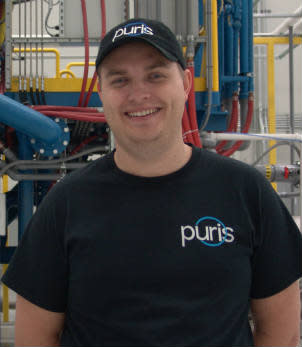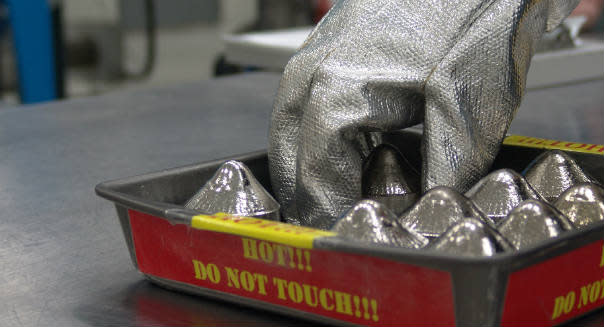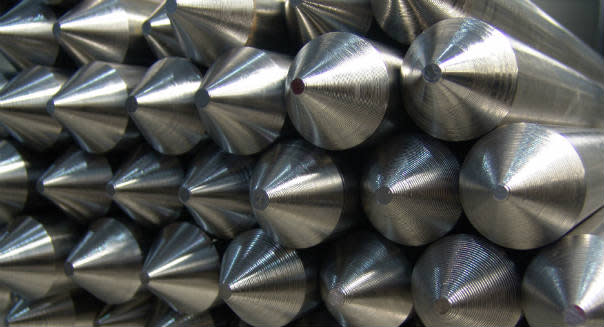From West Virginia, the World's Purest Titanium Powder

One of the hardest things about Matt DuBois' high tech job is trying to explain it to his friends and relatives who live in the rugged mountains of northeastern West Virginia.
First off, it's not the job DuBois expected to land -- he majored in history and religious studies at West Virginia University -- and he's a born-and-bred mountaineer, who plays guitar and loves to hike.
But at just 28, DuBois has found a great job he loves only 20 minutes from the small town where he grew up. His job: a production supervisor at Puris LLC, a small company that makes titanium powder in the tiny town of Bruceton Mills, West Virginia.

Most people know at least something about titanium, an expensive metal that's lighter and stronger than steel. One of Earth's most common elements, it's resistant to extreme heat and corrosion, which is why it's perfect for airplane parts, knee replacements and golf clubs.
But titanium powder is altogether different. Few people know much about it or how it's used. Made of millions of microscopic spherical titanium beads in a process that involves melting and atomizing bars of titanium, the powder is sold to manufacturers, who then turn it into the metal they use to make their titanium products.
It's safe to say there's no other job like DuBois' in his neck of West Virginia's woods. He's one of only 14 employees, including management, in a company not yet six months old. But his job -- his career, actually -- is looking more secure all the time.
While Puris doesn't come close to making the most titanium powder in the industry, says its CEO Craig Kirsch, it does make the purest titanium powder in the world with its one-of-a-kind all-titanium atomizer. And because the emerging 3-D printing industry is starting to increase its use of metals like powdered titanium, demand for the high-tech, high-quality product Puris makes is likely only to go up.

Chapter One: Printing with Powder
Until recently titanium powder was used mostly to make parts for the aerospace, medical and the oil and gas industries. But in the last few years, it's found a potentially huge market in 3-D printing, a manufacturing process that is rapidly changing the way many products are made.
New generations of large industrial printers can use super-thin layers of powdered metals, including titanium, to slowly "print out" almost any solid three-dimensional object designed and controlled by a computer. That includes everything from bicycle frames to a perfectly fitted human jawbone.
Titanium powder sells for upwards of $200 a pound, depending on the powder's size and purity. Absolute purity, which is what Puris specializes in, is crucial in making titanium powder. The smallest imperfection -- a single human hair, for instance -- can create a weak spot that can become a point of failure for whatever is made with the powder.
The 3-D printing boom changes everything for Puris, Kirsch says. He expects the revolutionary method of manufacturing to become the standard for how most titanium parts are made. It's fast, flexible and dramatically cuts production costs because 3-D printing uses less material than traditional manufacturing processes, which make metal parts from molded shapes that have to be milled or ground down. No one knows yet how big the demand for pure titanium powder will be, Kirsch says. But in the next four years he expects the 3-D printing industry to double its use of all grades of titanium powder.
Puris is ready to take advantage of that growth, he says. It already has the people, the patents, the equipment and the production capacity to make 300,000 pounds of pure titanium powder per year. That's more than any competitor, he says. Puris can also potentially double its production within a year or two by hiring just six workers and installing a second atomizer to make the powder.

Chapter 2: Titanium and Trust
Kirsch, 49, has a background in accounting and finance, not metallurgy. But in 2014 he and a group of investors created Puris by buying the uniquely valuable pieces of FMW Composite Systems, a Bridgeport, West Virginia, company that had gone bankrupt.
Originally started in 1993 to make rubber fuel systems for Army half-track vehicles, FMW evolved into producing titanium parts for both the military and commercial aerospace customers, including components for F-16 and F-22 fighter planes.
In 2012, FMW built the facility in Bruceton Mills to increase its production of an expensive composite material called TMC, which is made from titanium and silicon carbide fiber and used to make structural components for aerospace and military use. Some of its TMC went into the making of a light, but super-strong, cargo carrier that took supplies to the Hubble Space Telescope.
%VIRTUAL-pullquote-He felt the Bruceton Mills facility was a priceless national asset.%FMW needed the purest titanium powder it could get to make TMC and because no company was making it, it began producing the powder in-house. The company installed an advanced gas atomizer that melted titanium bars and turned the dripping metal into high-grade powder by blasting it with argon gas. When the large TMC program the company was working on for the federal government came to a successful end, FMW could find no customers for TMC in the private sector and in 2013 it had to file for bankruptcy.
Kirsch and his partners bought FMW in 2014 because he saw the growing market for titanium powder in 3-D printing. He also felt the Bruceton Mills facility was a priceless national asset and thought it would be a shame if it and its equipment were allowed to just disappear, be scattered or mothballed.
Kirsch then merged it with Summit Materials, a small Pittsburgh sales and consulting company owned by Eric Bono and research metallurgist Fred Yolton. Summit created and sold special wear-resistant titanium alloys for use by makers of bearings and knives. Bono and Yolton also briefly worked part-time at FMW before it went bankrupt. They helped design the patent-pending all-titanium atomizer that gives Puris the ability to make its pure titanium powder.
The merger was a perfect fit, Kirsch says. Puris needed Summit's brainpower and marketing savvy. Summit needed Puris' financial capital, assets and pure titanium powder. The parties trusted each other so much, say Kirsch and Bono, the deal was sealed with only a handshake and they worked together for several months until the merger became legal.
Bono, 41, is now Puris' vice president in charge of business development, looking for new uses for titanium powder. Yolton, 70, has the simpler title of "technical fellow," but his role is far more complicated than the title implies.
Yolton is a world-renowned pioneer in titanium powder atomization. "It's safe to say most people in the industry know who Fred Yolton is," says Kirsch, who jokingly, but reverentially, calls him "the godfather" of atomized powder.
Serene and professorial, Yolton spent his entire 45-year career in Pittsburgh working in powdered metallurgy at Crucible Materials Corp. Since 1990 his primary research has been on titanium powder, how to make it as pure as possible and what to make out of it.
He and Bono became colleagues and friends at Crucible in the early 2000s, and after Yolton retired in 2009 Bono asked him to start Summit Materials with him. Bono says he wouldn't have formed his company if Yolton hadn't agreed to become his partner. "There's not anyone else I would have trusted technically," he says.
Yolton says he's excited about being teamed up with a company that has the vision and courage to expand the use of titanium powder into the new and uncharted territory of 3-D printing.
Both Bono and Yolton commute to Bruceton Mills from Pittsburgh. Despite the distance, about 75 miles on the highway, being in Pittsburgh allows Yolton to continue his research into testing titanium powder in 3-D printers made by ExOne, a leader in industrial printing.
"Fred's helping us to look beyond what we're doing today," Kirsch says. "The 3-D printing companies who want to use titanium powder to make things don't know how to do it yet, and we ultimately want to teach them everything because we want them to buy our powder."
Chapter Three: Producing Pure Powder
Puris' nondescript white metal building shares an exit on Interstate 68 with a few trucking companies, a convenience store and a Microtel Inn that is Kirsch's second home when he commutes from Raleigh, North Carolina.
But step inside the cavernous 50,000-square-foot facility and you are transported into a brightly lit space with gleaming floors clear of any industrial clutter. A banner on a wall boasts the corporate slogan: "Puris -- Fanatically Clean."
The most important piece of equipment in the factory is the silver and gray atomizer FMW built in 2012 to make pure titanium powder. It's about 15 feet by 15 feet with a set of metal steps leading to an open-air control center that looks like the cab of diesel locomotive.
The atomizer melts titanium rods at 3,000 degrees in an all-titanium environment. Then it blasts the dripping metal with inert argon gas to create tiny beads of pure titanium. The industrial violence occurs out of sight inside the guts of the atomizer, which doesn't smoke or clang, but fills the plant with a loud steady hissing sound when it's working.
%VIRTUAL-pullquote-"These machines have a personality. If there's something weird going on, you can definitely tell." - Matt DuBois%No Puris employee actually ever sees the titanium in its powdered form. It falls into a sealed argon-packed canister and is transferred into a larger sealed container for shipping to customers. Nothing -- not a piece of fuzz or a whiff of oxygen -- can contaminate the final product.
Next to the atomizer sits the larger blue hulk of the plasma arc melter. Puris' customers usually supply their own titanium rods for melting, which contain the exact mix of alloys they want. But if Puris needs to make rods from scratch, this machine can transform 1,500 pounds of porous titanium ore -- or sponge, as it's called -- into six shiny bars 40 inches long and 2 inches wide.
Probably no one has a better feel for the technical idiosyncrasies, subtle sounds and day-to-day workings of the atomizer and the arc melter than DuBois.
He may be a mountaineer, not an engineer, but he has the kind of intimate, hands-on knowledge of the magical machines that can't be taught. DuBois helped construct Puris' building and he uncrated and put together the gas atomizer and the plasma arc melter bolt by bolt.
When he runs the atomizer, which is one of his favorite jobs, his musician's ear comes in handy. "The more you run something, the more familiar you get with it," he explains. "You can hear how much gas is flowing through it. You can feel how the machine is running. These machines have a personality. If there's something weird going on, you can definitely tell."
For more Made in the U.S.A. stories, go to This Built America.

